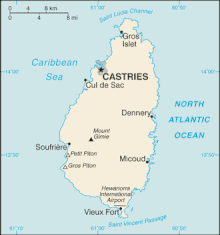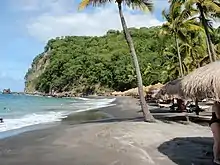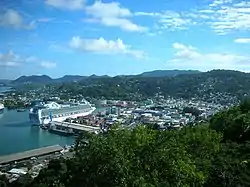Tourism in Saint Lucia
Saint Lucia, an island in the Caribbean islands, has a relatively large and lucrative tourism industry. Due to the relatively small land area of the country, most of the governmental promoting is performed by the state operated Saint Lucia Tourism Authority, led by Executive Chairperson Agnes.
Currency
Together with other states in the island chain, Saint Lucia is part of the Organisation of Eastern Caribbean States, whose Eastern Caribbean Central Bank is responsible for a currency union managing the Eastern Caribbean dollar (US$1 = EC$2.7).[1]
Area and location

Saint Lucia has the area of 239 squared miles (620 sq. km.). It is located in the eastern Caribbean Sea, in the windward islands.
- Coordinates 13°53′N, 60°68′W[2]
- Population: 158,178 (July 2001 est.) / World Rank: 180[2]
- Capital City: Castries, northern Saint Lucia[2]
- Largest City: Castries, population 53,000 (2000 est.)[2]

Tourism industry

Saint Lucia tends to be popular due to its tropical weather and scenery and for its large number of beaches and resorts. Warm sunshine, cozy beaches, stunning natural beauty – all are reason enough to escape the drudgery of winter and all are found in abundance on the unique Caribbean island of Saint Lucia. That is not all the island has to offer, the island has a rich, intriguing history, a flavorful culture, enticing cuisine, exciting sports and adventure activities, and it is known as one of the Caribbean's most spa oriented destinations.[3]
Ladera Resortis located on a volcano ridgeline, 1,000 feet above the Caribbean Sea, with views of the Pitons. The resort, set on the grounds on one of Soufrière's oldest cocoa plantations, has just 37 rooms and suites; all have a view of at least one Piton. Each room has its own private heated plunge pool to take in the views from. Local art can be found in the rooms and throughout the resort; this includes hand-carved works in all of the wood (from the headboards and support beams to poolside decorations)[4]
Dasheene is one of the top restaurants on St. Lucia. Executive Chef Nigel Mitchel and his staff use fresh, local ingredients; the chef prepares "stylish interpretations" of traditional St. Lucian dishes, such as sweet potato and coconut soup, Caribbean lamb salad, roast conch with pickled vegetables, Cajun Creole vegetable bakes, jerk poulet sausage, plantain gratin with coconut rum sauce and more. The restaurant is split into three levels: The Bar, a lunch section (which allows children, for non-hotel guests) and a dinner section. There is also a wine cellar, where guests can book a chef for a private dinner.[4]
The Spa at Ladera has three treatment rooms and an outdoor series of cascading hot tubs in the spa gardens (think pre- or post- massage).[4]
Cap Maison Resort & Spa. The 50-villa resort almost better resembles a Mediterranean cliffside hotel than it does a Caribbean resort. Oceanview Villa Suite with Pool & Roof Terrace. This room has a master bedroom, a living/ dining room, a kitchen and large private verandahs, as well as rooftop space — which offers a private swimming poo l, loungers and more. For a private meal, guests can have the resort prepare a barbecue dinner on their rooftop. There are two restaurants on property led by Head Chef Craig Jones: The Cliff at Cap which offers fine dining and a contemporary French Caribbean menu and The Naked Fisherman which serves more casual eats on the beach. Spa treatments, which range from rituals and journeys to body massages, facials and exfoliations, are available in the two treatment rooms, on the villa terraces, the pool, gazebo or on the beach. Group and private yoga, Pilates and fitness classes are also available. There are also two wine tastings offered: A casual, tutored tasting and a fine wine tasting. Cooking classes and more can also be booked for foodies.[4]
Beaches
Saint Lucia is known for the warm scenic beaches some of which are covered in black volcanic sand.[2] The island's beautiful climate, with temperature's averaging at 80 °F (27 °C) all year, make the beaches and the water all the more alluring and irresistible. Along with the good weather and the crystal clear water the island is inviting to many water adventures, everywhere from snorkeling to jet skiing to parasailing, it can all be done on the island. Although prices will vary but the overall the experience is worth having.
Culture

The Caribbean islands have a distinct culture from music to food to art. All of which is beautiful and extraordinary. The foods included exotic fruits and local meats and spices. Chefs on the island have many new flavors for tourists to try and experiment with. Music is full of new tones on the small island, genres ranging from jazz to reggae. Musicians from around the world travel to the small island to attend and perform at festivals. The art encompasses everything from the craftsmanship of the furniture to the paintings and clay sculptures. All around the island there are different type of art in the buildings and streets.
Safety and more
A report published by American Express Travel in 2006 revealed that St. Lucia is the world's top destination for weddings. According to the report, St. Lucia beat famous destinations like Las Vegas and the Maldives.[5] St. Lucia, like many other Caribbean countries, has been experiencing an increase in serious crime over the past few years. There has been an increase in robberies, burglaries, harassment, and even incidents of violent crime against tourists. Some of these cases have been reported in the international media and as such, St. Lucia's destination image is at risk. In an attempt to control the crime problem, the government has implemented a number of measures, which includes tougher penalties for some crime. However, these measures have not had a great effect on the crime rate. This has caused a noticeable decline on the tourist industry on the island.[6]
In an attempt to combat crime against tourists, the Minister of Tourism has adopted a number of measures. In collaboration with the Royal St. Lucia Police Force, they have commissioned a team of Special Constables, who have powers of arrest. These Constables were placed into two groups: the Rapid Response Team and the Rangers. The Rapid Response Team performs both foot and mobile patrol in the tourist/hotel areas both in the north and south of the island. The Rangers, also referred to as Beach Rangers, are responsible for patrolling the beaches near the hotels all over the island. By doing so the hope is to assure safety to the visitors on the islands. They also assist the hotel security by patrolling the hotel area.[6]
Additionally, the prominent tourist sites located in Soufriere, such as the Drive-in Volcano, The Rain Forest, The Diamond Falls, and The Piton Heritage Site have private security officers, who have been hired by the Ministry of Tourism. The Port police also provide security to the tourists from the time they leave the cruise vessel until they return to the port area. They also ensure that the tourist boats are secure while in the port. This is done in collaboration with the Marine Police who constantly patrol the seaport area while the tourist boats are in the harbor. Whenever tourist boats come to the island, police patrols are normally increased in the area in order to ensure that the tourists are secure while on the island.[6]
The Ministry of Tourism, in collaboration with the Royal St. Lucia Police, has also created a system of police audit checks on hotels. This system allows the police to carry out regular checks on security at the hotels around the island. They also advise the hotels on what security changes should be made in order to safeguard tourists. Tourists are still advised to be aware of any suspicious behavior and report anything immediately.[6]
Other attractions
Although cruises and beaches are what draw most tourists to Saint Lucia, other attractions include:

- The Pitons, two volcanic plugs rising more than 700 m directly from the sea that form part of a UNESCO World Heritage Site.
- Sulphur Springs - Located in Soufrière, it is the world's only drive-in volcano.[7]
- St. Lucia Botanical Gardens - This botanical garden has a wide variety of plant species, and a sulfur waterfall.
Saint Lucia, located in the eastern Caribbean Sea between Martinique and Saint Vincent, is the second- largest of the Windward Islands. The interior of the volcanically formed island consists of mountains and hills, and is surrounded by a coastal strip. The cone-like twin peaks of the Gros Piton and Petit Piton are Saint Lucia's outstanding natural feature.[2]
References
- Kinsbruner, Jay (2008). Encyclopedia of Latin American History and Culture. Detroit, MI: Charles Scribner's Sons. pp. 668–669.
- McCoy, John (2003). "Saint Lucia". Geo-data : the world geographical encyclopedia (Third ed.). Detroit, MI: Gale. pp. 462–464. ISBN 9780787677084.
- "The Warmth of Pampering - Saint Lucia Style". Canadian Travel Press. 44 (14). 2012 – via EBSCO Hospitality and tourism complete.
- Turner, Matt (2018). "Saint Lucia". Luxury Travel Advisor: 4–8 – via EBSCO Hospitality and tourism complete.
- "St Lucia: Top wedding venue". BBC Caribbean.com. 2006.
- Leonard, Johnny (July 2007). "Tourism and Crime in the Caribbean: A case study of St Lucia". Annals of Leisure Research. 10 (3–4): 475–497. doi:10.1080/11745398.2007.9686777 – via Hospitality and Tourism Complete.
- "Soufrière Travel Guide". Retrieved 2007-05-19.
